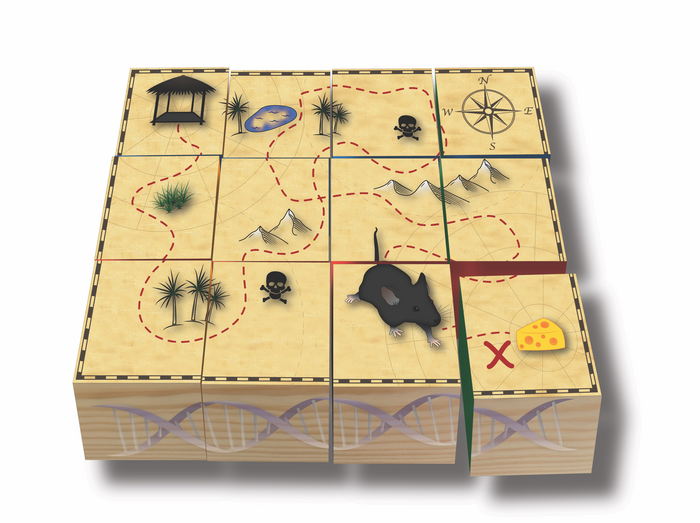“Second-guessing” is a hard-wired behavior, study suggests
IMAGE: UNIVERSITY OF UTAH HEALTH SCIENTISTS HAVE FOUND THAT GENES BIAS DECISION-MAKING, EVEN DECISIONS THAT SEEM IRRATIONAL. view more
CREDIT: CORNELIA STACHER-HÖRNDLI, PHD
Have you ever made a decision that, in hindsight, seemed irrational? A new study with mice, which could have implications for people, suggests that some decisions are, to a certain extent, beyond their control. Rather, the mice are hard-wired to make them.
“This research is telling us that animals are constrained in the decisions they make,” says Christopher Gregg, PhD, a neurobiologist at University of Utah Health and senior author of the study that recently published in iScience. “Their genetics push them down one path or another.”
Gregg and his research team started investigating decision-making after noticing mice repeatedly making what appeared to be an irrational decision. After finding a stash of hidden seeds, rather than staying put to eat them, mice kept returning to a location that had food in it the day before. Only on this day, the original location was empty.
“It was as if the mice were second-guessing whether the first location really had no food,” Gregg says. “Like they thought they had missed something.”
To Gregg and the study’s co-authors, the behavior didn’t make any sense. The animals ended up eating less because of the time spent continuously returning to the empty food patch. If that kind of behavior causes mice to eat less in the wild, it could spell trouble, Gregg explains, because not getting enough calories can be detrimental for a mouse.
The real surprise came after discovering that mice lacking a specific gene didn’t “second-guess” where to go and instead were more likely to stay and eat the food they found. As a result, they consumed more calories overall. This was the first evidence the scientists found that genes could bias decision-making, even decisions that did not seem logical, at least to a human. In this case, the gene Arc appeared to be important for compelling the mice to continue searching for food even when it didn’t appear to be necessary.
“We all have a clear sense of what it is like to second-guess something, but who would have thought that this type of behavior could be so profoundly affected by one gene?” says Cornelia Stacher- Hörndli, PhD, neurobiologist and co-author. “This raises the question, are other cognitive biases under genetic control?”
Decoding behavior
To the human eye, a mouse’s life seems pretty simple. When placed in a naturalistic setting in Gregg’s lab, they left home, explored their surroundings, searched for food, ate a little, and made stops back home in between. But the view looked quite different after a machine learning algorithm deconstructed their journeys.
A custom program built by Gregg and study co-author Jared Emery analyzed 1,609 foraging excursions and saw that the mice repeated 24 behavior sequences over and over. As the mice foraged, they strung together the sequences like building blocks, interspersing them with spontaneous behaviors to construct more complex behavior patterns. One of them was the second-guessing behavior. “To a certain extent, you could predict the future,” Gregg remarks.
That future changed for mice missing the gene, Arc. Six of the 24 behavior sequences were altered, and together, those differences short-circuited the second-guessing behavior. Previous research had shown Arc is involved in learning and memory. But overall, analysis showed that the mice’s memory—and their other behaviors—were largely intact. The implication is that the effect on those six behaviors was specific.
“One intriguing idea is that the animals evolved to make those decisions because they were somehow advantageous in the wild,” Gregg says. He explains one possibility: when mice go back and forth to evaluate previous food locations, it helps them create a mental map. And that might help them find food faster the next time around. “Genetically controlled cognitive bias may allow for effective decision-making during foraging,” he says.
The question remains, is there a biological basis for other types of cognitive bias? And could genes guide decision-making in humans? More research will tell. “I believe that this research is foundational for a new field that we are calling ‘decision genetics,’” Stacher-Hörndli says.
Mice carry out a finite number of stereotyped behaviors while foraging 
Machine learning algorithms showed that as mice foraged for food, they strung together a finite number of stereotyped behavioral sequences like building blocks, interspersing them with spontaneous behaviors to construct more complex behavior patterns.
CREDIT
Cornelia Stacher-Hörndli, PhD
In addition to Gregg and Stacher-Hörndli, additional co-authors are Alicia Ravens, Susan Steinward, and Jason Shepherd from University of Utah Health and Jared Emery from Storyline Health, Inc.
The research was supported by grants from the National Institutes of Health and published as “Arc Regulates a Second-Guessing Cognitive Bias During Naturalistic Foraging Through Effects on Discrete Behavior Modules.”
About University of Utah Health
University of Utah Health provides leading-edge and compassionate care for a referral area that encompasses Idaho, Wyoming, Montana, and much of Nevada. A hub for health sciences research and education in the region, U of U Health has a $458 million research enterprise and trains scientists, the majority of Utah’s physicians, and health care providers at its Colleges of Health, Nursing, and Pharmacy and Schools of Dentistry and Medicine. With more than 20,000 employees, the system includes 12 community clinics and five hospitals. U of U Health is recognized nationally as a transformative health care system and provider of world-class care.
JOURNAL
iScience
METHOD OF RESEARCH
Experimental study
SUBJECT OF RESEARCH
Animals
ARTICLE TITLE
Arc regulates a second-guessing cognitive bias during naturalistic foraging through effects on discrete behavior modules
ARTICLE PUBLICATION DATE
24-May-2023
COI STATEMENT
C.G. is a co-founder of and has equity in Storyline Health Inc., which uses artificial intelligence to build scalable research and clinical tools for precision medicine, and has advisory roles in Rubicon A.I., DepoIQ, and Uncharted Health. J.E. is an employee of Storyline Health.
No comments:
Post a Comment